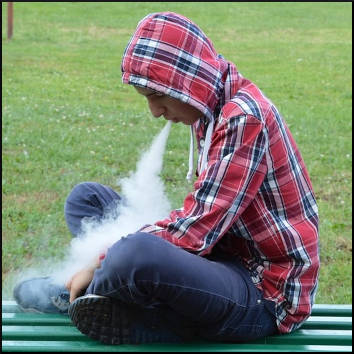
Is vaping worth asthma-like breathing?

Photo by Krystian Graba
A just-released study raises concern that vaping e-cigarettes could trigger an inflammatory response similar to what's seen in asthma. As evidenced by countless quit vaping support group posts, difficulty breathing is already an issue:
- "I'm so tired of not even being able to walk up the stairs without losing my breath, and the stupid scary lung pains I get when I lay down, and how I depend on this stupid device ..." (source)
- "I'm an extremely heavy vaper, when I say extremely I mean it as I’m constantly vaping non-stop from the moment I wake up till I fall asleep. I feel like I cannot inhale enough oxygen with each breath, I'm 19 and very fit yet I literally cannot even sit on a chair without feeling exhausted and nauseous ..." (source)
- "After 4 years of loving you, I had to do this. You made me short of breath as soon as I'd take a drag. I've tried various flavors, flavorless, no PG, ect., and still couldn't breathe well. My pulmonary function tests have declined because of you. I can breathe better without you." (source)
Entitled "Nicotine promotes e-cigarette vapour-induced lung inflammation and structural alterations" (free full-text PDF), according to the new study's authors, "In summary, we showed that the presence of nicotine in e-cigarette vapour promoted acute endothelial damage, pulmonary inflammation and chronic pulmonary functional and structural alterations."
Released early online by the European Respiratory Journal, researchers found that in vitro exposure to nicotine-containing e-cigarette vapour extract caused a decrease in gene expression and proliferation of epithelial cells and pulmonary arterial smooth muscle cells by 29.3% in human lung tissue and by 44.3% in mice.
Additionally, the study found that acute or short-term inhalation of nicotine-containing e-cigarette vapour increased pulmonary endothelial permeability, allowing leaking or increased movement of fluids into the interstitium and pulmonary air spaces, which could cause pulmonary edema and inflammation.
When assessing long-term exposure in mice (8 months), they discovered a significant increase in the number of inflammatory cells. Specifically, lymphocytes among mice receiving nicotine vapor extract as compared to controls were 23 times greater (853.4 vs. 37 cells per mL−1), and in lung tissue were 5 times greater (25.7 vs. 4.8 cells per·mL−1).
What about nicotine-free vape? Although substantially less than nicotine's 853.4 cells per mL−1, nicotine-free vaping extract also increased bronchoalveolar lavage lymphocytes compared to controls (198.6 vs. 37 cells per mL-1).
Researchers also found that vaped nicotine extract caused significant changes in lung structure and function (e.g. increase in airspace by 17.5% compared to control), noting that it's "similar to mild tobacco smoke-induced alterations."
The authors openly acknowledge that e-cigarette health risk findings have, to date, been hugely inconsistent.
They note that "large variability of e-liquid content (e.g. flavours, nicotine), technical specifications of e-cigarettes (e.g. voltage, temperature) and user habits (e.g. puff duration, number of puffs), and the relatively short period that e-cigarettes have been in use hamper robust scientific conclusions, in particular, those concerning their long-term effects."
"Plasma nicotine levels of 3.8±0.9ng/ml in our study are comparable to low concentrations in human e-cigarette users. In clinical studies, the levels of nicotine in the plasma of e-cigarette users vary from ~1ng/ml to ~50ng/ml depending on study design, the e-cigarette device, etc."
Still, as the authors note, "studies in humans reported discrepant results with a decrease, an increase or no change of inflammatory markers after short-term use of e-cigarettes, with longer-term in vivo vaping studies finding "the development of [cigarette-smoke-like] lung structural alterations, such as emphysema, have been reported; some studies show signs of emphysema after 4 months, and others demonstrate no effect after 8 months."
So, how should e-cig users view the tremendous diversity in vaping respiratory findings?
The study closes by noting that, "although research on e-cigarette use is hampered by the lack of standardization in methods to produce and apply e-cigarette vapour, this diversity may reflect the variety of human situations in which application depends on e-liquid composition, puffing topography and e-cigarette characteristics."
Yes, hundreds of unique devices delivering varying amounts of nicotine within thousands of different flavoring cocktails using a wide spectrum of power settings, not to mention each user's unique puffing profile, is it any wonder that science is having difficulty declaring if and when vaping lung injury occurs, and whose breathing will or won't be impaired?
The smart move? Plan on continued vaping soon making breathing noticeably harder. That way, you won't be surprised should it happen. More importantly, hopefully, it will aid you in coming to your senses about remaining addicted to inhaling nature's most potent natural insecticide. It's risky and dangerous.
#NicotineFree2023 Yes you can!
 John R. Polito received his JD from the University of South Carolina School of Law in 1985, where he graduated Wig & Robe. He is a former 3-pack-a-day thirty-year smoker and the 1999 founder of WhyQuit. A nicotine cessation educator since 2000, John mentored under Joel Spitzer for two decades, presenting more than 100 live nicotine dependency recovery programs modeled after Joel's programs. He is the author of "Freedom from Nicotine - The Journey Home," "Smart Turkey," 6 peer-reviewed journal articles, and founder and director of Turkeyville, a 15,000-member Facebook support group exclusively for cold turkey quitters. Email: johnpolito54@gmail.com
John R. Polito received his JD from the University of South Carolina School of Law in 1985, where he graduated Wig & Robe. He is a former 3-pack-a-day thirty-year smoker and the 1999 founder of WhyQuit. A nicotine cessation educator since 2000, John mentored under Joel Spitzer for two decades, presenting more than 100 live nicotine dependency recovery programs modeled after Joel's programs. He is the author of "Freedom from Nicotine - The Journey Home," "Smart Turkey," 6 peer-reviewed journal articles, and founder and director of Turkeyville, a 15,000-member Facebook support group exclusively for cold turkey quitters. Email: johnpolito54@gmail.com

